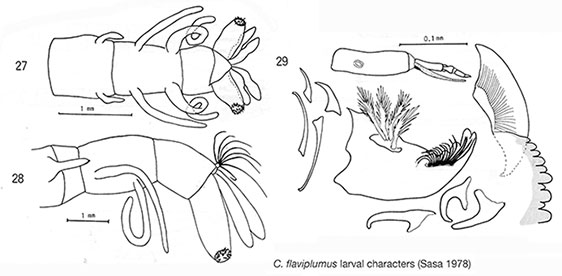C. flaviplumus Tokunaga immatures Larva: a medium sized plumosus-type larva (length about 14.0-14.8 mm.).  Anterior ventral tubules (1.14-1.20 mm.) shorter than posterior pair 1.40-(1.52 mm.). Anal tubules long and cylindrical, about 2.3-3.2 times longer than wide, ventral pair possibly slightly shorter and thicker (260 x 100; 250 x 110 micron). Gula pale or very slightly darkened on posterior third; frontoclypeus slightly dark to dark. Mentum (Fig. b) with square sharp teeth, c2 teeth of central trifid tooth well separated from c1 tooth (type III), 4th laterals slightly reduced (type I-II). Pecten epipharyngis (Fig. a) with about 16-21 variable but sharp teeth. Ventromentum (Fig. c) with about 29-36 striae; VMR 0.27-0.38. Antenna (Fig. d) with a moderately long basal segment, which is about 4-4.5 times as long as wide; RO about a third to 2/5 up from base; AR about 1.75-1.96. Antennal proportions: 122 : 31 : 10 : 13 : 6. Distance between antennal bases possibly greater than that between the S4 setae. Mandible (Fig. e) with third inner tooth only partly separated and darkened (Type IA-IIB), and with about 12-14 furrows on outer surface at the base; about 10-12 taeniae in Pecten mandibularis. Cytology: 4 polytene chromosomes with the pseudothummi arm combination AE, BF, CD, G. Chromosome arms A, E and F were described by Wülker et al. (1989) as C. samoensis. However, some sequences of Australian specimens are not the same, although closely related. |
Modified: 5 March 2019
Access: Unrestricted
Copyright © 2009-2019, Jon Martin.